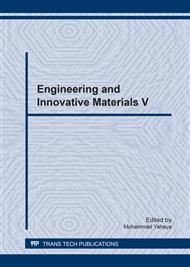[1]
B.A. Baum, Metallic Liquids, Nauka Moscow, (1979).
Google Scholar
[2]
B.A. Baum, G.A. Hasin, G.V. Tyagunov et. al. Liquid Steel, Metallurgia, (1984).
Google Scholar
[3]
A.M. Samarin, Physico-Chemical Basis of Metallurgical Processes, Nauka Moscow, (1969).
Google Scholar
[4]
I.P. Prigojin, From Being to Becoming, Nauka Moscow, (1970).
Google Scholar
[5]
B.A. Baum, G.V. Tyagunov, E.E. Baryshev, and V.S. Tsepelev, Equilibrium and Nonequilibrium States of Metal Melts, Fundamental Studies of the Physical Chemistry of Metallic Melts, Academia Books, (2002) 214-228.
Google Scholar
[6]
Ye. G. Shvidkovskiy, Certain Problems Related to the Viscosity of Fused Metals, National Aeronautics and Space Administration, Washington, (1962).
Google Scholar
[7]
V.V. Konashkov, V.S. Tsepelev, V.V. V`yukhin, A.M. Povodator, and A.I. Podol`skaya, A Computer-Aided Plant for Studying the Kinematic Viscosity of High-Temperature Metallic Melts, J. Instruments and Experimental Techniques, 54 (2) (2011) 284-285.
DOI: 10.1134/s0020441211020187
Google Scholar
[8]
V.S. Tsepelev, V.V. Konashkov, V.V. Vyukhin, A.M. Povodator, RU Patent 2, 366, 925 (2009).
Google Scholar
[9]
V.V. Vyukhin, V.V. Konashkov, V.S. Tsepelev, A.M. Povodator, RU Patent 2, 535, 525 (2014).
Google Scholar
[10]
A. Povodator, V. Tsepelev, V. Konashkov, V. Vyukhin. Investigation of Non-Monotonic Portions on the Temperature Dependences of High-Temperature Metal Melts` Physical Properties, J. Advanced Materials Research, (1064) (2015) 38-41.
DOI: 10.4028/www.scientific.net/amr.1064.38
Google Scholar
[11]
G. Cai, C. Li. Effect of Ce on Incusions, Microstructure, Mechanical Properties, and Corrosion Behavior of AlSl 202 Stanless Steel, J. of Materials Engineering and Performance, 2015, Vol. 24, Issue 10 (2015) 3889-4009.
DOI: 10.1007/s11665-015-1651-6
Google Scholar
[12]
S.P. Burmasov, A.V. Murzin, L.E. Dresvyankina, V.V. Meling. Eliminating Corrosive Nonmetallic Inclusions from Pipe Steel, Steel in Translation, Vol. 44, Issue 6 (2014) 439-443.
DOI: 10.3103/s0967091214060059
Google Scholar


